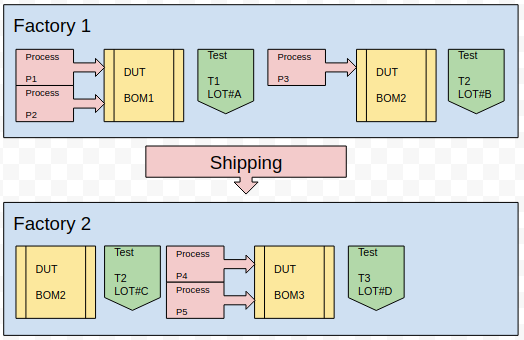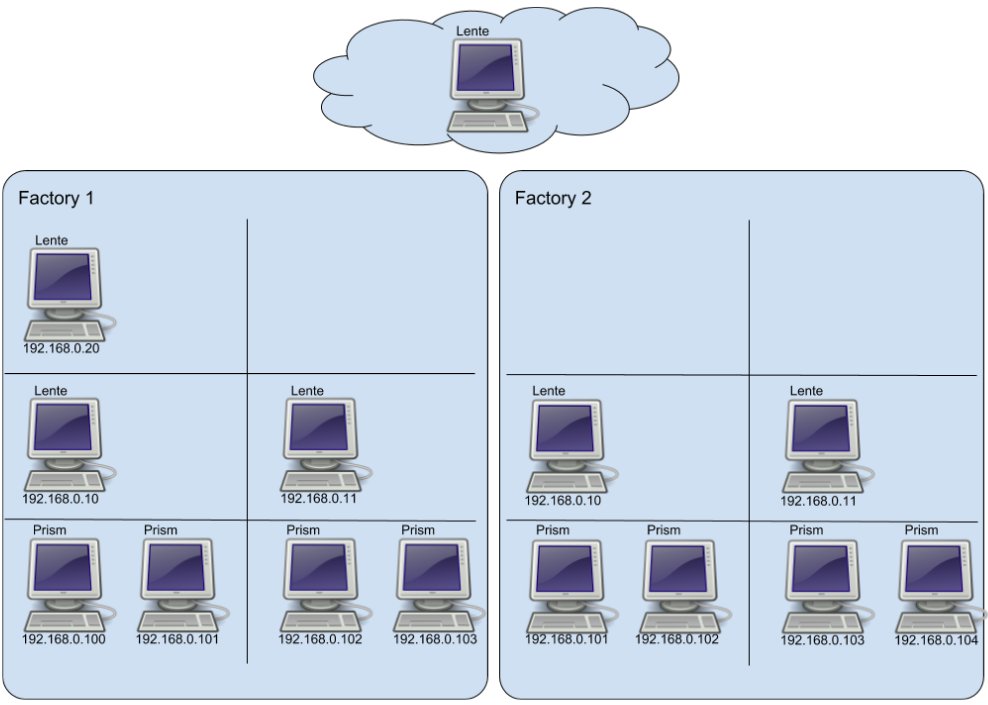Production Planning¶
What follows is a general discussion of a production flow, and how Lente/Prism would be configured.
Production Infrastructure Cycle¶

The above diagram presents a flow for developing and deploying scripts.
Git is used as a repository for development and releases.
Lente script sync is used to deploy scripts to Prism stations.
Stages¶
Consider the following simplified production flow diagram,

There are two factories belonging to two different sub-contractors
The product is represented by
DUTFactory 1 does two process steps (P1 and P2) to create the first version of the DUT, called BOM1 (Bill of Materials)
The product is then tested, T1
Then process step P3 is done, creating DUT BOM2, and the product is tested again, T2
The DUT is shipped to the next factory, and the first thing that is done is a repeat of the (outgoing) test T2, this is so that any DUT material damaged in shipping is quantified before Factory 2 does any processing.
This re-testing is referred to as “incoming” inspection/test
This is often required so that damaged or faulty DUT can be quantified before more processing is done on the DUT
Responsibility for damaged or faulty product needs to be assigned to the right sub-contractor
File Organization¶
Naming and organizing the location of files is a difficult thing to prescribe because your needs may require a specific solution. Regardless, a general proposal will be given and from there one can create a more specific solution.
The proposed general purpose solution assumes that version control is an important issue for you.
Consider the following scenario. A product is in full production and there is a test that is having a 1% failure rate, but none of the customer returns are associated with failures for this test. So an ECO is created to change the limit of the test to reduce the failure rate to an expected 0.5%. How should you implement this change so that you can track the new failure rate? Or search if a product returned would have failed at the previous limit? These are the kinds of things you need to think about when you implement test program and script files.
Prism has a high level prescribed directory structure.
Constraints:
all Prism files must be under
./public/prismall script files must be under
./public/prism/scripts
Naming Conventions¶
A naming strategy is totally up to you. No strategy at also is also a choice.
That being said, experience has taught that not having a strategy very quickly leads to confusion and chaos. If you end up being successful, upfront planning will really pay off 1-2 years down the road when try to piece together when you built what, with what version of that, with what ECO, on what version of BOM, …
Many small companies try to be cool and come up with nifty names to describe things. That works short term but falls apart down the road. The worst thing that can happen to you is that your successful!
There is a reason why big companies use seemingly random numbers to name things… it works. But you do need a “secret decoder ring” to determine what something is when you just have a generic number as a label. This is whgat you keep track of in a spreadsheet (which is the secret decoder ring).
Prism needs the names of the following,
scripts
specific to
product
stage (T1, T2, & T3 in the diagram)
version
program files
specific to
script
stage (T1, T2, & T3 in the diagram)
version
common (to everything)
Test Items (these are the test IDs indicated in the scripts and implemented in programs)
specific to
product
stage (T1, T2, & T3 in the diagram)
version
This is a lot to wrap your head around, so to avoid future confusion, a proposal for structure is presented.
Naming Proposal¶
All of these naming conventions, versions, will end up in the results file, in that way, you precisely know by which scripts, programs, and methods a test was done.
Product naming
P###mm
### => 000, 001, etc, represents a class of product
mm => 00, 01, etc, model or version of the product
In a spreadsheet (or other tool) keep a list of P### that correspond to internal project names, or actual BOM numbers, etc.
Test Script naming
P###mm_Tssvv_DESCRIPTION.scr
ss => 00, 01, etc, represents test stage number
vv => 00, 01, etc, version
Test Program naming (product specific)
P###mm_Tssvv_DESCRIPION.py
the test script and test program don’t need to have the same name
Test Program naming (common)
Fnnnvv_DESCRIPTION.py
nnn => 000, 001, etc, represents test number
vv => 00, 01, etc, version
Test Method naming
TSTnnnvv_DESCRIPTION
nnn => 000, 001, etc, represents test number
Example of files,
./public/prism/scripts/companyName
./public/prism/scripts/companyName/P001
./public/prism/scripts/companyName/P001/P00100_T0100_SmokeTests.scr
./public/prism/scripts/companyName/P001/P00100_T0100_SmokeTests.py
./public/prism/scripts/companyName/P001/P00100_T0200_LoadFinalCode.scr
./public/prism/scripts/companyName/P001/P00100_T0200_LoadFinalCode.py
./public/prism/scripts/companyName/comm/F00100_ResetSTM32F479.py
Example script P00100_T0100_SmokeTests.scr,
{
"info": {
"product": "P001_Shazam",
"bom": "B00012-001",
"lot": "1922-1",
"location": "FACTORY1"
},
"config": {
"result": "public.prism.result.ResultBaseKeysV1",
"fail_fast": false,
"drivers": ["public.prism.drivers.fake.fake"]
},
"tests": [
{
"module": "public.prism.scripts.companyName.comm.F00100_ResetSTM32F479",
"options": {},
"items": [
{"id": "TST0100_setBOOT0", "enable": true, "args": {"out": "LOW"}},
{"id": "TST0200_powerVDD", "enable": true, "args": {"value": "3300"}},
{"id": "TST0300_delayMS", "enable": true, "args": {"delay_ms": 1000}},
]
},
{
"module": "public.prism.scripts.companyName.P001.P00100_T0100_SmokeTests",
"options": {},
"items": [
{"id": "TST0100_powerUP", "enable": true },
{"id": "TST0200_measVDD", "enable": true, "args": {"min": 3100, "max": 3400},
"fail": [{"fid": "TST02-1", "msg": "Component U1"},
{"fid": "TST02-2", "msg": "Component R1"}]},
{"id": "TST0300_measVCC", "enable": true, "args": {"min": 2600, "max": 2800},
"fail": [{"fid": "TST03-1", "msg": "Component U2"}]},
]
}
]
}
Example program F00100_ResetSTM32F479,
! /usr/bin/env python
# -*- coding: utf-8 -*-
import logging
from core.test_item import TestItem
from public.prism.api import ResultAPI
# file name and class name must match
class F00100_ResetSTM32F479(TestItem):
def __init__(self, controller, chan, shared_state):
super().__init__(controller, chan, shared_state)
self.logger = logging.getLogger("SC.{}.{}".format(__name__, self.chan))
def TST0100_setBOOT0(self):
context = self.item_start() # always first line of test
...
self.item_end() # always last line of test
def TST0200_powerVDD(self):
context = self.item_start() # always first line of test
...
self.item_end() # always last line of test
def TST0300_delayMS(self):
context = self.item_start() # always first line of test
...
self.item_end() # always last line of test
Example program P00100_T0100_SmokeTests,
! /usr/bin/env python
# -*- coding: utf-8 -*-
import logging
from core.test_item import TestItem
from public.prism.api import ResultAPI
# file name and class name must match
class P00100_T0100_SmokeTests(TestItem):
def __init__(self, controller, chan, shared_state):
super().__init__(controller, chan, shared_state)
self.logger = logging.getLogger("SC.{}.{}".format(__name__, self.chan))
def TST0100_powerUP(self):
context = self.item_start() # always first line of test
...
self.item_end() # always last line of test
def TST0200_measVDD(self):
context = self.item_start() # always first line of test
...
self.item_end() # always last line of test
def TST0300_measVCC(self):
context = self.item_start() # always first line of test
...
self.item_end() # always last line of test
IP Addressing¶
What follows is a simple design for allocating the IP addresses of Prism and Lente computers. You may decide to do this differently.
Assumptions:
Fixed IP addresses are used
the LAN IP is 192.168.0.X
Prism IPs¶
Label each PC what its IP address is
Addresses
192.168.0.100 (first Prism)
192.168.0.101
192.168.0.102
etc
Lente IPs¶
Label each PC what its IP address is
Addresses
192.168.0.10 (first Lente, at lowest level in hierarchy)
192.168.0.20 (second Lente, at next level in hierarchy)
etc
Example¶
In this example there are two factories,
no computers are exchanged between the factories
note Factory 1 has two levels of Lente, and note the IP addressing
The IP address of Lente in the cloud is unknown, and is typically given to you
